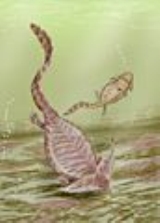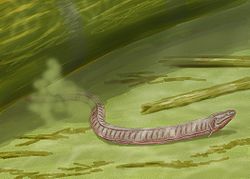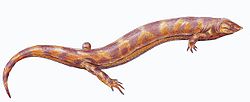
Lepospondyli
Encyclopedia
Lepospondyli are a group of small but diverse Carboniferous
to early Permian
tetrapod
s. Six different groups are known, the Acherontiscidae
, Adelospondyli
, Aïstopoda
, Lysorophia
, Microsauria
and Nectridea
, and between them they include newt-like, eel- or snake-like, and lizard-like forms, along with species that do not fit any current category. Various species were aquatic, semi-aquatic, or terrestrial. None were large (the biggest genus, the keraterpetontid Diplocaulus
, reached a meter in length, but most were much smaller), and it can be assumed that they lived in specialised ecological niches not taken by their more numerous Temnospondyl
contemporaries.
, but rather grew as bony cylinders around the notochord
. In addition, the upper portion of the vertebra, the neural arch, is usually fused to the centra (the main body of the vertebra) (Colbert 1969).
No clear common ancestors are known, since each of the known clades are already highly specialised when they first appear in the fossil record. It is not known whether the lepospondyls are an artificial (polyphyletic) group which independently evolved similar characteristics of the vertebra, or whether they descended from a single common ancestor.
At one time it was thought that some lepospondyls are related or perhaps ancestral to modern Urodela, but not the other modern amphibians
, although this view is no longer held (see Batrachomorpha
). For a long time they were considered one of the three subclasses of amphibian
s (Romer 1966, Colbert 1969, Carroll 1988). More recently, it has been suggested that the lepospondyls may be related or ancestral to modern amphibians as well as to amniotes (reptiles etc) (Laurin 1996), that they are an artificial grouping with some members related to both extinct and living amphibians (Batrachomorpha
) but not amniotes (Benton 2000), or alternatively are a monophyletic group closely related to the ancestry of amniotes but not to recent amphibians (Benton 2004).
Apart from the Nectridea, lepospondyls are limited in distribution to Europe and North America (Carroll 1988).



 Class Amphibia
Class Amphibia
Carboniferous
The Carboniferous is a geologic period and system that extends from the end of the Devonian Period, about 359.2 ± 2.5 Mya , to the beginning of the Permian Period, about 299.0 ± 0.8 Mya . The name is derived from the Latin word for coal, carbo. Carboniferous means "coal-bearing"...
to early Permian
Permian
The PermianThe term "Permian" was introduced into geology in 1841 by Sir Sir R. I. Murchison, president of the Geological Society of London, who identified typical strata in extensive Russian explorations undertaken with Edouard de Verneuil; Murchison asserted in 1841 that he named his "Permian...
tetrapod
Tetrapod
Tetrapods are vertebrate animals having four limbs. Amphibians, reptiles, birds and mammals are all tetrapods; even snakes and other limbless reptiles and amphibians are tetrapods by descent. The earliest tetrapods evolved from the lobe-finned fishes in the Devonian...
s. Six different groups are known, the Acherontiscidae
Acherontiscus
Acherontiscus caledoniae is an extinct species of prehistoric amphibians that lived during the Carboniferous.-See also:* Prehistoric amphibian* List of prehistoric amphibians...
, Adelospondyli
Adelospondyli
Adelospondyli are an order of elongate, presumably aquatic, Carboniferous amphibians. The skull is solidly roofed, and elongate, with the orbits located very far forward. The limbs are well developed. There is a single family, the Adelogyrinidae...
, Aïstopoda
Aïstopoda
Aïstopoda is an order of highly specialised snake-like amphibians known from the Carboniferous and Early Permian of Europe and North America, ranging from tiny forms only , to nearly in length...
, Lysorophia
Lysorophia
Lysorophia is an order of aquatic Carboniferous and Permian amphibians within the extinct subclass Lepospondyli. Lysorophians resembled small snakes, as their bodies are extremely elongate. There is a single family, the Lysorophidae...
, Microsauria
Microsauria
Microsauria is an extinct order of lepospondyl amphibians from the late Carboniferous and early Permian periods. It is the most diverse and species-rich group of lepospondyls. Recently, Microsauria has been considered paraphyletic, as several other non-microsaur lepospondyl groups such as...
and Nectridea
Nectridea
Nectridea is an extinct order of lepospondyl amphibians from the Carboniferous and Permian periods, which included animals such as Diplocaulus. In appearance, they would have resembled modern newts or aquatic salamanders. They had long flattened tails to aid in swimming, and well-developed hind...
, and between them they include newt-like, eel- or snake-like, and lizard-like forms, along with species that do not fit any current category. Various species were aquatic, semi-aquatic, or terrestrial. None were large (the biggest genus, the keraterpetontid Diplocaulus
Diplocaulus
Diplocaulus is an extinct genus of leponspondyl amphibian from the Permian period of North America.- Description :...
, reached a meter in length, but most were much smaller), and it can be assumed that they lived in specialised ecological niches not taken by their more numerous Temnospondyl
Temnospondyli
Temnospondyli is a diverse order of small to giant tetrapods—often considered primitive amphibians—that flourished worldwide during the Carboniferous, Permian, and Triassic periods. A few species continued into the Cretaceous. Fossils have been found on every continent...
contemporaries.
Classification
All lepospondyls are characterised by having simple, spool-shaped vertebra, which were not preformed as cartilageCartilage
Cartilage is a flexible connective tissue found in many areas in the bodies of humans and other animals, including the joints between bones, the rib cage, the ear, the nose, the elbow, the knee, the ankle, the bronchial tubes and the intervertebral discs...
, but rather grew as bony cylinders around the notochord
Notochord
The notochord is a flexible, rod-shaped body found in embryos of all chordates. It is composed of cells derived from the mesoderm and defines the primitive axis of the embryo. In some chordates, it persists throughout life as the main axial support of the body, while in most vertebrates it becomes...
. In addition, the upper portion of the vertebra, the neural arch, is usually fused to the centra (the main body of the vertebra) (Colbert 1969).
No clear common ancestors are known, since each of the known clades are already highly specialised when they first appear in the fossil record. It is not known whether the lepospondyls are an artificial (polyphyletic) group which independently evolved similar characteristics of the vertebra, or whether they descended from a single common ancestor.
At one time it was thought that some lepospondyls are related or perhaps ancestral to modern Urodela, but not the other modern amphibians
Lissamphibia
The subclass Lissamphibia includes all recent amphibians and means smooth amphibia.Extant amphibians fall into one of three orders — the Anura , the Caudata or Urodela , and the Gymnophiona or Apoda .Although the ancestry of each group is still unclear, all share certain common characteristics,...
, although this view is no longer held (see Batrachomorpha
Batrachomorpha
Batrachomorpha is a name traditionally given to recent and extinct amphibians that are not related to reptiles. It most often includes the extinct groups Temnospondyli and Lepospondyli.-Origin of the term:...
). For a long time they were considered one of the three subclasses of amphibian
Amphibian
Amphibians , are a class of vertebrate animals including animals such as toads, frogs, caecilians, and salamanders. They are characterized as non-amniote ectothermic tetrapods...
s (Romer 1966, Colbert 1969, Carroll 1988). More recently, it has been suggested that the lepospondyls may be related or ancestral to modern amphibians as well as to amniotes (reptiles etc) (Laurin 1996), that they are an artificial grouping with some members related to both extinct and living amphibians (Batrachomorpha
Batrachomorpha
Batrachomorpha is a name traditionally given to recent and extinct amphibians that are not related to reptiles. It most often includes the extinct groups Temnospondyli and Lepospondyli.-Origin of the term:...
) but not amniotes (Benton 2000), or alternatively are a monophyletic group closely related to the ancestry of amniotes but not to recent amphibians (Benton 2004).
Apart from the Nectridea, lepospondyls are limited in distribution to Europe and North America (Carroll 1988).
Taxonomy




- Subclass LEPOSPONDYLI
- Order AdelospondyliAdelospondyliAdelospondyli are an order of elongate, presumably aquatic, Carboniferous amphibians. The skull is solidly roofed, and elongate, with the orbits located very far forward. The limbs are well developed. There is a single family, the Adelogyrinidae...
- Family AcherontiscidaeAcherontiscusAcherontiscus caledoniae is an extinct species of prehistoric amphibians that lived during the Carboniferous.-See also:* Prehistoric amphibian* List of prehistoric amphibians...
- Order AïstopodaAïstopodaAïstopoda is an order of highly specialised snake-like amphibians known from the Carboniferous and Early Permian of Europe and North America, ranging from tiny forms only , to nearly in length...
- Family LethiscidaeLethiscusLethiscus is the earliest known representative of the Aïstopoda, a group of very specialised snake-like amphibians known from the Carboniferous and Permian....
- Family OphiderpetonOphiderpetonOphiderpeton is an extinct genus of lepospondyl amphibian from the Carboniferous period. Remains of this genus are widespread and were found in Ohio, USA and the Czech Republic ....
tidae - Family OestocephalidaeOestocephalidaeOestocephalidae is an extinct family of Late Carboniferous aïstopod lepospondyls. Fossils have been found from Ohio, Illinois, and Colorado in the United States; England; and the Czech Republic. It includes the genera Coloraderpeton and Oestocephalus. Oestocephalids have robust skulls and narrow,...
- Family PseudophlegethontiidaePseudophlegethontiaPseudophlegethontia is an extinct genus of aïstopod lepospondyl. It is the only member of the family Pseudophlegethontiidae. The only species is the type species P. turnbullorum, named in 2003...
- Family Phlegethontiidae
- Family Lethiscidae
- Order NectrideaNectrideaNectridea is an extinct order of lepospondyl amphibians from the Carboniferous and Permian periods, which included animals such as Diplocaulus. In appearance, they would have resembled modern newts or aquatic salamanders. They had long flattened tails to aid in swimming, and well-developed hind...
- ArizonerpetonArizonerpetonArizonerpeton is an extinct genus of nectridean lepospondyl....
- Family Scincosauridae
- Family KeraterpetontidaeKeraterpetontidaeKeraterpetontidae is an extinct family of lepospondyl amphibians that arose during the Late Carboniferous and died out during the early Permian period....
- Family Urocordylidae
- Arizonerpeton
- Superorder MicrosauriaMicrosauriaMicrosauria is an extinct order of lepospondyl amphibians from the late Carboniferous and early Permian periods. It is the most diverse and species-rich group of lepospondyls. Recently, Microsauria has been considered paraphyletic, as several other non-microsaur lepospondyl groups such as...
- Family OdonterpentontidaeOdonterpetonOdonterpeton is an extinct genus of microbrachomorph microsaur.-See also:* Prehistoric amphibian* List of prehistoric amphibians...
- TuditanomorphaTuditanomorphaTuditanomorpha is a suborder of microsaur lepospondyls. Tuditanomorphs lived from the Late Carboniferous to the Early Permian and are known from North America and Europe. Tuditanomorphs have a similar pattern of bones in the skull roof. Tuditanomorphs display considerable variability, especially in...
- Family Pantylidae
- Family TuditanidaeTuditanidaeTuditanidae is an extinct family of tuditanomorph microsaurs. Fossils have been found from Nova Scotia, Ohio, and the Czech Republic and are Late Carboniferous in age.Tuditanids were medium-sized terrestrial microsaurs that resembled lizards...
- Family HapsidopareiontidaeHapsidopareiontidaeHapsidopareiontidae is an extinct family of tuditanomorph microsaurs. Hapsidopareiontids are known from the Early Permian of the United States and possibly Germany and the Czech Republic....
- Family GymnarthridaeGymnarthridaeGymnarthridae is an extinct family of tuditanomorph microsaurs. Gymnarthrids are known from Europe and North America and existed from the Late Carboniferous through the Early Permian. Remains have been found from the Czech Republic, Nova Scotia, Illinois, Texas, and Oklahoma.Gymnarthrids are...
- Family OstodolepidaeOstodolepidaeOstodolepidae is an extinct family of tuditanomorph microsaurs. They are unique among microsaurs in that they were large, reaching lengths of up to , terrestrial, and presumably fossorial. Ostodolepid remains have been found from Early Permian beds in Texas and Oklahoma.Ostodolepids have elongated...
- Family TrihecatonTrihecatonTrihecaton is an extinct genus of microsaur. It is the only member of the family Trihecatontidae.-See also:* Prehistoric amphibian* List of prehistoric amphibians...
tidae - Family GoniorhynchidaeRhynchonkosRhynchonkos is an extinct genus of microsaur. It is the only member of the family Goniorhynchidae. Originally known as Goniorhynchus, it was renamed in 1981. The type and only species is R. stovalli, found from the Early Permian Hennesey Formation in Cleveland County, Oklahoma...
- Family BrachystelechidaeBrachystelechidaeBrachystelechidae is an extinct family of Early Permian microsaurs. The family was first named by Robert L. Carroll and Pamela Gaskill in 1978, with the only member being Brachystelechus fritschi. Brachystelechus fritschi has since been reassigned to the genus Batropetes...
- Order LysorophiaLysorophiaLysorophia is an order of aquatic Carboniferous and Permian amphibians within the extinct subclass Lepospondyli. Lysorophians resembled small snakes, as their bodies are extremely elongate. There is a single family, the Lysorophidae...
- Family Lysorophidae
- Family Odonterpentontidae
- Order Adelospondyli

